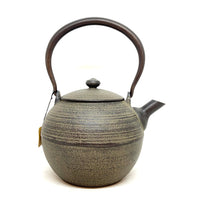Tetsubin - Aged Iron - 1.5 L - #HS66L



Tetsubin - Aged Iron - 1.5 L - #HS66L
Made in Yamagata, Japan
Comes boxed with a booklet on how to care your for your pot.
The function of the Tetsubin is unique. It can significantly change the taste of water. When brewing tea using water boiled in Tetsubin, the taste of the tea becomes very mellow and sweet. In addition, thanks to the iron content of the kettle, the resultant water can possibly offer additional health benefits.
The water boiled in a tetsubin is not only suitable for the preparation of tea. It can be utilized as simple drinking water; as water for the making of coffee; or even as water in the making soup. As you will see, the taste of the water produced in a Tetsubin is uniquely different from that of water boiled in any other ordinary cooking device.
The chemical structure of water is part of the key that explains how water changes when boiled in a Tetsubin. The water molecule (H2O) consists of two elements, hydrogen (+)and oxygen (-).These elements carry both positive and negative electrical affinities or charges, just like a magnet. This is called dipole in Chemistry. These equal electrical charges that exist in both oxygen and hydrogen, cause water molecules to constantly spin when in a liquid state . If they stop spinning, then water will become ice. Variable intensity of hydrogen bond allows the flavor and texture of water to change depending on the instrument utilized when boiling it. For example, if there is no mineral content in the instrument utilized to boil the water, for instance, a sterile glass beaker, the positive and negative charges of the elements of the water molecule will simply be attracted to each other and form their network or molecule through their hydrogen bonds. These bonds give water it's characteristic viscosity and surface tension, but a plain or flat flavor. However, when minerals exist in the instrument utilized to boil the water, for example, the Tetsubin, the elements of the water molecule are attracted to the minerals from the Tetsubin instead. In fact, the affinity of the water molecule with certain types of minerals in the Tetsubin is stronger than those existing between the water molecules themselves. Minerals and water molecules form more stable bonds. This stronger attraction between minerals and water molecules also increases the viscosity and surface tension of the water. This effects our perception of the flavor and texture of the water itself, and most importantly, our taste buds can feel more taste, and a taste that stays longer in our mouths thanks to the stronger attraction of these hydrogen bonds and the metal ions of the Tetsubin.
The presence of minerals also affects the depth of the water's flavor. Minerals attract volatile flavor producing substances and form stronger hydrogen bonds in water. The stronger these hydrogen bonds are, the slower the evaporation of such volatile substances becomes. As the result of slow evaporation, we feel a much deeper and longer lasting flavor in our mouth.
In general, the use of a Tetsubin will enhance the taste of the water used. It will give your water a pleasant after taste and long lasting flavor. For tea drinkers who are seeking to enjoy a stronger after taste in their tea, a Tetsubin is suitable for all types of tea. In addition , it will reduce the unwanted aromas of your water. Usually, the first thing that a novice Tetsubin user tends to appreciate is the change in the aroma of his tea, rather than the actual taste and you will find that the cup brewed using water from a Tetsubin will definitely have a deeper aroma and flavor.
AKIRA HOJO
This kettle is for boiling water on the stovetop and is not intended for brewing tea leaves.



